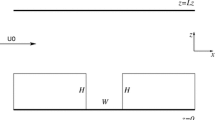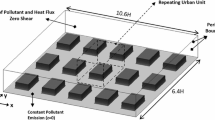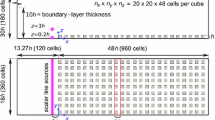Abstract
Thermal stratification (neutral, unstable and stable) plays an important role in determining the transport processes in and above urban street canyons. This paper summarizes the recent findings of the effect of thermal stratification on the transport of momentum, heat, and pollutants in the two-dimensional (2D) urban street canyons in the skimming flow regime. Special attention is paid to the results from large-eddy simulations (LESs), while other experimental and numerical results are referred to when necessary. With increasing Richardson number, \(Ri\), the drag coefficient of the 2D street canyon as felt by the overlying atmosphere decreases in a linear manner. Under neutral and stable stratification, a nearly constant drag coefficient of 0.02 is predicted by the LESs. Under unstable stratification, the turbulent pollutant transport is dominated by organized turbulent motions (ejections and sweeps), while under stable stratification, the unorganized turbulent motion (inward interactions) plays a more important role and the sweeps are inhibited. The unstable stratification condition also enhances the ejections of turbulent pollutant flux, especially at the leeward roof-level corner, where the ejections dominate the turbulent pollutant flux, outweighing the sweeps. With increasing \(Ri\), both the heat (area active scalar source) and pollutant (line passive scalar source) transfer coefficients decrease towards a state where the transfer coefficients become zero at \(Ri \approx 0.5\). It should be noted that, due to the limit of the 2D street canyon configuration discussed in this paper, great caution should be taken when generalising the conclusions drawn here.





Similar content being viewed by others
References
Fernando HJS, Lee SM, Anderson J, Princevac M, Pardyjak E, Grossman-Clarke S (2001) Urban fluid mechanics: air circulation and contaminant dispersion in cities. Environ Fluid Mech 1:107–164
Britter RE, Hanna SR (2003) Flow and dispersion in urban areas. Annu Rev Fluid Mech 35:469–496
Belcher SE (2005) Mixing and transport in urban areas. Philos Trans R Soc A 363:2947–2968
Fernando HJS, Zajic D, Di Sabatino S, Dimitrova R, Hedquist B, Dallman A (2010) Flow, turbulence, and pollutant dispersion in urban atmospheres. Phys Fluids 22(051):301
Allegrini J, Dorer V, Carmeliet J (2013) Wind tunnel measurements of buoyant flows in street canyons. Build Environ 59:315–326
Gandemer J, Guyot A (1976) Integration du Phenomene Vent dans la Conception du Milieu Bati: Guide Methodologique et Conseils Pratiques. Premiere Ministre, Groupe Central des Villes Nouvelles, Secretariat General, Ministere de la Qualite de la Vie, France, p 139
Ng E, Yuan C, Chen L, Ren C, Fung J (2011) Improving the wind-environment in high-density cities by understanding urban morphology and surface roughness: a study in Hong Kong. Landscape Urban Plan 101:59–74
Yuan C, Ng E (2012) Building porosity for better urban ventilation in high-density cities: a computational parametric study. Build Environ 50:176–189
Li XX, Liu CH, Leung DYC, Lam KM (2006) Recent progress in CFD modelling of wind field and pollutant transport in street canyons. Atmos Environ 40(29):5640–5658
Kanda M (2007) Progress in urban meteorology: a review. J Meteorol Soc Jpn 85:363–383
Louka P, Belcher SE, Harrison RG (2000) Coupling between air flow in streets and the well-developed boundary layer aloft. Atmos Environ 34:2613–2621
Oke T (1988) Street design and urban canopy layer climate. Energy Build 11:103–113
Bottema M (1993) Wind climate and urban geometry. Eindhoven University of Technology, Eindhoven, p 212
Harman IN, Belcher SE (2006) The surface energy balance and boundary layer over urban street canyons. Q J R Meteorol Soc 132(621):2749–2768
Simoens S, Ayrault M, Wallace JM (2007) The flow across a street canyon of variable width—part 1: kinematic description. Atmos Environ 41(39):9002–9017
Huq P, Carrillo A, White LA, Redondo J, Dharmavaram S, Hanna SR (2007) The shear layer above and in urban canopies. J Appl Meteorol Climatol 46:368–376
Cui Z, Cai XM, Baker CJ (2004) Large eddy simulation of turbulent flow in a street canyon. Q J R Meteorol Soc 599:1373–1394
Brown GL, Roshko A (1974) On density effects and large structure in turbulent mixing layers. J Fluid Mech 64(04):775–816
Princevac M, Baik JJ, Li X, Pan H, Park SB (2010) Lateral channeling within rectangular arrays of cubical obstacles. J Wind Eng Ind Aerodyn 98(8):377–385
Li XX, Liu CH, Leung DYC (2008) Large-eddy simulation of flow and pollutant dispersion in urban street canyons with wall model. Boundary-Layer Meteorol 129(2):249–268
Li XX, Liu CH, Leung DYC (2009) Numerical investigation of pollutant transport characteristics inside deep urban street canyons. Atmos Environ 43(15):2410–2418
Cai XM (2012a) Effects of differential wall heating in street canyons on dispersion and ventilation characteristics of a passive scalar. Atmos Environ 51:268–277
Scaperdas A, Robins AG, Colville RN (2000) Flow visualisation and tracer dispersion experiments at street canyon intersections. Int J Environ Pollut 14:526–537
Boddy JWD, Smalley RJ, Dixon NS, Tate JE, Tomlin AS (2005) The spatial variability in concentrations of a traffic-related pollutant in two street canyons in york—part I: the influence of background winds. Atmos Environ 39(17):3147–3161
Kastner-Klein P, Berkowicz R, Britter RE (2004) The influence of street architecture on flow and dispersion in street canyons. Meteorol Atmos Phys 87(1):121–131
Robins A, Savory E, Scaperdas A, Grigoriadis D (2002) Spatial variability and source-receptor relations at a street intersection. Water Air Soil Pollut Focus 2(5):381–393
Carpentieri M, Robins AG, Baldi S (2009) Three-dimensional mapping of air flow at an urban canyon intersection. Boundary-Layer Meteorol 133(2):277–296
Vardoulakis S, Fisher BEA, Pericleous K, Gonzalez-Flesca N (2003) Modelling air quality in street canyons: a review. Atmos Environ 37:155–182
Rafailidis S (1997) Influence of building area density and roof shape on the wind charateristics above a town. Boundary-Layer Meteorol 85:255–271
Rafailidis S (2000) Near-field geometry effects on urban street canyon measurements for model validation. Int J Environ Pollut 14(1):538–546
Louka P, Belcher S, Harrison R (1998) Modified street canyon flow. J Wind Eng Ind Aerodyn 74:485–493
Eliasson I, Offerle B, Grimmond C, Lindqvist S (2006) Wind fields and turbulence statistics in an urban street canyon. Atmos Environ 40(1):1–16
Caton F, Britter RE, Dalziel S (2003) Dispersion mechanism in a street canyon. Atmos Environ 37:693–702
Salizzoni P, Soulhac L, Mejean P (2009) Street canyon ventilation and atmospheric turbulence. Atmos Environ 43(32):5056–5067
Ho CM, Huerre P (1984) Perturbed free shear layers. Annu Rev Fluid Mech 16:365–422
Salizzoni P, Marro M, Soulhac L, Grosjean N, Perkins RJ (2011) Turbulent transfer between street canyons and the overlying atmospheric boundary layer. Boundary-Layer Meteorol 141(3):393–414
Wallace JM, Eckelman H, Brodkey RS (1972) The wall region in turbulent shear flow. J Fluid Mech 54:39–48
Cheng WC, Liu CH (2011a) Large-eddy simulation of flow and pollutant transports in and above two-dimensional idealized street canyons. Boundary-Layer Meteorol 139(3):411–437
Michioka T, Sato A, Takimoto H, Kanda M (2011) Large-eddy simulation for the mechanism of pollutant removal from a two-dimensional street canyon. Boundary-Layer Meteorol 138(2):195–213
Kim JJ, Baik JJ (2003) Effects of inflow turbulence intensity on flow and pollutant dispersion in an urban street canyon. J Wind Eng Ind Aerodyn 91:309–329
Michioka T, Sato A (2012) Effect of incoming turbulent structure on pollutant removal from two-dimensional street canyon. Boundary-Layer Meteorol 145:469–484
Antonia RA, Raupach MR (1993) Spectral scaling in a high reynolds number laboratory boundary layer. Boundary-Layer Meteorol 65(3):289–306
Högström U, Bergström H (1996) Organized turbulence structures in the near-neutral surface layer. J Atmos Sci 53:2452–2464
Nakamura Y, Oke TR (1988) Wind, temperature, and stability conditions in an east-west-oriented urban canyon. Atmos Environ 22:2691–2700
Ca VT, Asaeda T, Ito M, Armfield S (1995) Characteristics of wind field in a street canyon. J Wind Eng Ind Aerodyn 57(1):63–80
Sini JF, Anquetin S, Mestayer PG (1996) Pollutant dispersion and thermal effects in urban street canyons. Atmos Environ 30:2659–2677
Uehara K, Murakami S, Oikawa S, Wakamatsu S (2000) Wind tunnel experiments on how thermal stratification affects flow in and above urban street canyons. Atmos Environ 34:1553–1562
Xie X, Liu CH, Leung DYC, Leung MKH (2006) Characteristics of air exchange in a street canyon with ground heating. Atmos Environ 40(33):6396–6409
Turner JS (1973) Buoyancy effects in fluids. Cambridge University Press, Cambridge
Strang EJ, Fernando HJS (2001) Entrainment and mixing in stratified shear flows. J Fluid Mech 428:349–386
Louka P, Vachon G, Sini JF, Mestayer PG, Rosant JM (2002) Thermal effects on the airflow in a street canyon—Nantes ’99 experimental results and model simulations. Water Air Soil Pollut Focus 2(5—-6):351–364
Xie ZT, Hayden P, Wood CR (2013) Large-eddy simulation of approaching-flow stratification on dispersion over arrays of buildings. Atmos Environ 71:64–74
Solazzo E, Britter RE (2007) Transfer processes in a simulated urban street canyon. Boundary-Layer Meteorol 124(1):43–60
Li XX, Britter RE, Koh TY, Norford LK, Liu CH, Entekhabi D, Leung DYC (2010) Large-eddy simulation of flow and pollutant transport in urban street canyons with ground heating. Boundary-Layer Meteorol 137(2):187–204. doi:10.1007/s10546-010-9534-8
Li XX, Britter RE, Norford LK, Koh TY, Entekhabi D (2012) Flow and pollutant transport in urban street canyons of different aspect ratios with ground heating: large-eddy simulation. Boundary-Layer Meteorol 142(2):289–304
Christen A, van Gorsel E, Vogt R (2007) Coherent structures in urban roughness sublayer turbulence. Int J Climatol 27:1955–1968
Shaw RH, Tavangar J, Ward DP (1983) Structure of the Reynolds stress in a canopy layer. J Clim Appl Meteorol 22:1922–1931
Kang YS, Baik JJ, Kim JJ (2008) Further studies of flow and reactive pollutant dispersion in a street canyon with bottom heating. Atmos Environ 42:4964–4975
Cai XM (2012b) Effects of wall heating on flow characteristics in a street canyon. Boundary-Layer Meteorol 142:443–467
Garratt JR (1992) The atmospheric boundary layer. Cambridge University Press, Cambridge
Cheng WC, Liu CH (2011b) Large-eddy simulation of turbulent transports in urban street canyons in different thermal stabilities. J Wind Eng Ind Aerodyn 99(4):434–442
Barlow JF, Harman IN, Belcher SE (2004) Scalar fluxes from urban street canyons. Part I: laboratory simulation. Boundary-Layer Meteorol 113(3):369–385
Cai XM, Barlow JF, Belcher SE (2008) Dispersion and transfer of passive scalars in and above street canyons—large-eddy simulations. Atmos Environ 42:5885–5895
Pal Arya S (2001) Introduction to micrometeorology, 2nd edn. Academic Press, San Diego
Inagaki A, Castillo MCL, Yamashita Y, Kanda M, Takimoto H (2012) Large-eddy simulation of coherent flow structures within a cubical canopy. Boundary-Layer Meteorol 142:207–222
Branford S, Coceal O, Thomas TG, Belcher SE (2011) Dispersion of a point-source release of a passive scalar through an urban-like array for different wind directions. Boundary-Layer Meteorol 139(3):367–394
Xie ZT (2011) Modelling street-scale flow and dispersion in realistic winds—towards coupling with mesoscale meteorological models. Boundary-Layer Meteorol 141(1):53–75
Zhang YW, Gu ZL, Cheng Y, Lee SC (2011) Effect of real-time boundary wind conditions on the air flow and pollutant dispersion in an urban street canyon–large eddy simulations. Atmos Environ 45(20):3352–3359
Solazzo E, Di Sabatino S, Aquilina N, Dudek A, Britter RE (2010) Coupling mesoscale modelling with a simple urban model: the Lisbon case study. Boundary-Layer Meteorol 137(3):441–457
Ryu YH, Baik JJ, Lee SH (2011) A new single-layer urban canopy model for use in mesoscale atmospheric models. J Appl Meteorol Climatol 50(9):1773–1794
Kanda M, Moriwaki R, Kasamatsu F (2004) Large-eddy simulation of turbulent organized structures within and above explicitly resolved cube arrays. Boundary-Layer Meteorol 112(2):343–368
Acknowledgments
This project was funded by Singapore National Research Foundation (NRF) through the Singapore-MIT Alliance for Research and Technology (SMART) Center for Environmental Sensing and Modeling (CENSAM). Rex Britter also acknowledges the support from the Senseable City Laboratory, MIT.
Author information
Authors and Affiliations
Corresponding author
Rights and permissions
About this article
Cite this article
Li, XX., Britter, R.E. & Norford, L.K. Transport processes in and above two-dimensional urban street canyons under different stratification conditions: results from numerical simulation. Environ Fluid Mech 15, 399–417 (2015). https://doi.org/10.1007/s10652-014-9347-2
Received:
Accepted:
Published:
Issue Date:
DOI: https://doi.org/10.1007/s10652-014-9347-2




